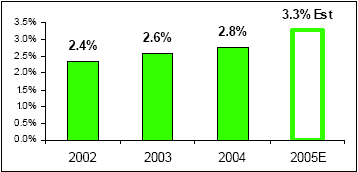IDEX Online Research: Blue Nile Taking Market Share from Store-Based Jewelers
September 11, 05
Blue Nile
Internet retailing is here to stay, and Blue Nile is proving that to the jewelry industry every day. During the second quarter ended June, Blue Nile’s gains were astounding: its total sales, average ticket, and number of orders rose far more sharply than any of the other publicly held U.S. companies. Further, it posted a dramatic profit gain in the quarter, a relatively slow period when many jewelers report a loss.
June 2005 Quarter
$ Mil % Chg Total Sales $43.8 +25% Pretax Profits $4.4 +49%
While other jewelers continue to tinker with an internet selling strategy, Blue Nile has pulled far beyond the rest of the industry in its ability to capture and retain customers. It clearly is the Amazon.com of the jewelry industry. While the road to jewelry internet sales success is littered with failed merchants, Blue Nile has pulled so far ahead in a race so skewed that we can’t tell who is in second place.
| Blue Nile Revenue Growth |
From its launch in 1999 – just six short years ago – Blue Nile is expected to post sales of $210 million this year, making it the ninth largest specialty jeweler in America.
If you are a jeweler, you’d do well to at least understand – if not mimic – some of the strategies and tactics which have fueled Blue Nile’s success. Two good places to start: 1) go to Blue Nile’s web site and see how it operates; 2) read everything about the company, including its SEC filings which contain a treasure-trove of information about Blue Nile’s business model.
Highlights of the company’s second quarter results illustrate how this company has prospered.
- Blue Nile’s total sales rose by 25.1%; both pre-tax and after-tax profits rose by about 49%. No other public company posted results nearly this strong.
- The company’s average ticket rose to $1,441, up more than 10%. The typical mass market jeweler’s average ticket is in the $300-400 range. Total orders rose by 12.9%.
- Three factors drove Blue Nile’s sales:
- Engagement rings – Blue Nile’s average ticket for an engagement ring was $5,558 in 2004, well above the industry average of $2,600 (based on DTC research).
- Diamond jewelry demand – This category excludes engagement rings, but includes all other bridal jewelry as well as non-bridal jewelry. Management noted that demand for larger diamonds was very strong in the quarter.
- Loose diamonds – Because Blue Nile sells loose diamonds for low prices, consumers now look to Blue Nile for their loose diamond needs (we suspect that more than a few independent retailers may also be buying loose diamonds from Blue Nile).
- Engagement rings – Blue Nile’s average ticket for an engagement ring was $5,558 in 2004, well above the industry average of $2,600 (based on DTC research).
- Roughly 74% of Blue Nile’s sales came from engagement ring sales. The typical mass market jeweler generates roughly 35% of their sales from all bridal categories.
- Blue Nile reported that its wholesale price of diamonds rose by a “low single digit” amount in the quarter; in contrast, some other jewelers reported larger diamond price increases. Perhaps Blue Nile really is buying better, especially since larger diamonds – which have been carrying premium wholesale prices – rose as a percentage of the company’s total sales mix.
- The company’s gross margin rose to 22.8% versus 22.6%. That’s about half of the margin which a traditional jewelry reports. In short, Blue Nile really does sell jewelry for much less than most store-based jewelers.
- Blue Nile’s advertising costs were about 4% of sales; this is roughly in line with the amount spent by traditional jewelers.
- Its annual inventory turn (on a trailing twelve-month basis) was 17.0x, up from the prior year’s 16.5x. This is one of the key secrets to Blue Nile’s profitability. Traditional jewelers are lucky if they turn their inventory 1.0x to 1.2x annually; if memo goods are included, traditional store-based jewelers turn their inventory about 0.7x annually. This is abysmal performance, by any measure. This is also why jewelers have such difficulty obtaining bank financing.
- Generating internet sales is very difficult. Blue Nile’s conversion rate (browser to buyer) is about 1%. In other words, 99% of the people who look at Blue Nile’s site don’t buy anything. A word of warning: if you rely on ComScore data to track Blue Nile’s website traffic, you are being misinformed, according to management. ComScore numbers for Blue Nile are apparently wildly high.
- Repeat customers are primarily driving sales. Purchases from repeat customers are growing twice as rapidly as purchases from new customers. Shoppers who buy an engagement ring from Blue Nile – especially a very high-priced engagement ring – are among the company’s most loyal customers. Those who buy non-engagement jewelry are not nearly as loyal. Smart jewelers understand the concept of “lifetime value” of a customer. Blue Nile’s best customers are young and have above average incomes; they are likely to live in a tech-rich market. In short, it is likely that these customers will remain loyal to Blue Nile for many years.
- Blue Nile is targeting markets both in Canada and the United Kingdom. In the U.K., it is building a tech center which will support its operations throughout Western Europe.
U.S. Online Jewelry Sales
as a Percentage of Total U.S. Jewelry Sales
Source: IDEX Research
